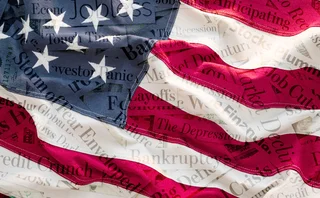
Uncertain rates outlook poses challenge for corporate FX hedgers
Hedging programmes may need a revamp as EM/G10 rates differentials narrow
If 2023 was the year of predictable global interest rate rises, 2024 could prove to be a bit more uncertain.
Many observers believe US rates have finally peaked, and a lot of banks are pricing that the Federal Reserve will make its first cut in March with five quarter-point cuts to follow. Others predict the European Central Bank will follow suit in the second quarter, as will the Bank of England.
What foreign exchange hedgers – and those at corporates, in particular – will be keeping an eye on are the various interest rate differentials between the US and other countries.
Last year, the wide gap in these differentials between G10 and emerging market (EM) countries led to a flock of investors utilising the carry trade strategy to profit from currencies with much higher interest rates, including the Brazilian real, Colombian peso and Mexican peso.
For US and European corporates, the differentials were reflected in increased costs when using FX forwards to hedge future cash flows from emerging markets.
As the year progressed, these differentials began to shrink as some countries started cutting their benchmark rates. Brazil made its first cut of 50 basis points in August, taking rates to 13.25%, and has since made a cut of 50bp every month. Colombia, meanwhile, cut its benchmark rate by 2.5bp to 13%. This has led to a fall in Brazilian real and Colombian peso non-deliverable forward points.
The outlier appears to be Mexico. The country’s central bank has maintained its hawkish stance by holding interest rates at 11.25% for a sixth straight meeting, meaning the carry could still make the peso more expensive for hedging.
Some banks – like Deutsche Bank in a recent note – suggest the next 12 months will see a narrowing of EM/G10 interest rate differentials and cheaper opportunities to hedge as a result. The Deutsche note states that vol levels will determine how EM currencies will perform as the carry buffer is removed.
In preparation for this uncertainty, corporate treasurers are adopting more sophisticated technologies for managing currency risks, including carry, and using this data to adjust their FX hedging programmes.
If the carry differential between G10 and EM currencies compresses, large multinationals with sophisticated programmes could increase their hedge ratios for EM currencies to the upper bound of their policies and lengthen their hedges.
At the same time, bank sales teams have been touting more advanced hedging structures that can allow corporates to minimise costs.
Some, for example, have looked to create a basket of hedges – a portfolio – where instead of paying carry on individual EM currency pairs, they have aggregated several correlated pairs together in order to benefit from net carry effects. In other words, instead of worrying whether one currency pair is too expensive to hedge, the performance is determined by the aggregate hedging cost of the portfolio of currencies.
As corporates become more comfortable with using options for hedging purposes, dealers are also offering structured forwards that include embedded options, which might, for instance, allow corporates to participate to a certain extent in the upside.
More banks are also offering so-called floating spot forwards. This product allows a corporate to lock in the forward points but allow the spot component to float over a given period. When the spot has risen sufficiently during that time it could be locked in, at which point the product converts to a regular FX forward comprising the new spot rate plus the previously fixed forward points.
It is a structure that was initially used by UK power provider Drax, but until recently only a handful of banks were able to offer it.
With corporates looking to be more proactive as markets potentially enter a cycle of global interest rate cuts, capitalising on these flows will become even more crucial for banks. Banks with large corporate franchises performed much better in the first half of 2023 than those with mainly institutional flows, and this pattern looks set to be repeated in the second half.
Only users who have a paid subscription or are part of a corporate subscription are able to print or copy content.
To access these options, along with all other subscription benefits, please contact customer services - www.fx-markets.com/static/contact-us, or view our subscription options here: https://subscriptions.fx-markets.com/subscribe
You are currently unable to print this content. Please contact customer services - www.fx-markets.com/static/contact-us to find out more.
You are currently unable to copy this content. Please contact info@fx-markets.com to find out more.
Copyright Infopro Digital Limited. All rights reserved.
As outlined in our terms and conditions, https://www.infopro-digital.com/terms-and-conditions/subscriptions/ (point 2.4), printing is limited to a single copy.
If you would like to purchase additional rights please email info@fx-markets.com
Copyright Infopro Digital Limited. All rights reserved.
You may share this content using our article tools. As outlined in our terms and conditions, https://www.infopro-digital.com/terms-and-conditions/subscriptions/ (clause 2.4), an Authorised User may only make one copy of the materials for their own personal use. You must also comply with the restrictions in clause 2.5.
If you would like to purchase additional rights please email info@fx-markets.com
More on Trading
Dealers bullish on Bloomberg chat interface for FX markets
Service expanded its API offering to integrate broker chats into banks’ engines for cash FX pricing late last year
Corporates hamstrung in response to FX volatility
Restrictions around hedging programmes leave US firms struggling to adapt to dollar weakness
Hedge funds flock to hybrids to trade macro uncertainty
Firms repurpose structure made popular by Trump trades last year
FX traders revel in March Madness
Chaotic Trump policies finally bring diversity to flows – to the delight of market-makers
Former Nomura FX co-head joins JB Drax Honoré
Kevin Connors joins agency broker as head of business and client development
FX Spot+: connecting OTC traders to FX futures liquidity
CME Group’s new all-to-all spot FX marketplace translates futures liquidity into spot terms, expanding liquidity access to OTC traders
Asia hours surge complicates FX options market-making
Late tariff announcements in US trigger hedging headaches during less-liquid Asia sessions
Automated market-making tested by intraday FX vol
Price gaps in spot FX markets could be exacerbated by algos trading on headline risk








